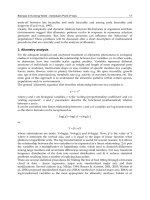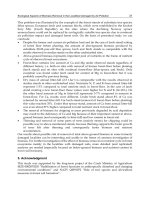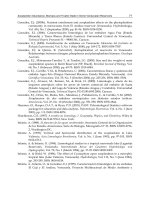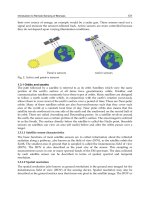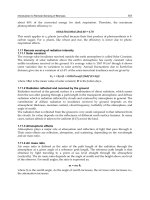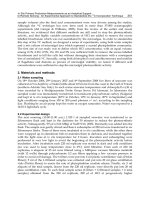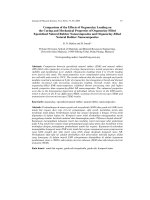Materials Science and Engineering - Electronic and Mechanical Properties of Materials Part 2 pot
Bạn đang xem bản rút gọn của tài liệu. Xem và tải ngay bản đầy đủ của tài liệu tại đây (217.01 KB, 10 trang )
3.225
21
Example: Conductivity Engineering
• Objective: increase strength of Cu but keep conductivity high
τ
τ
µ
τ
σ
v
m
e
m
ne
=
==
l
2
Scattering length
connects scattering time
to microstructure
Dislocation
(edge)
l decreases, τ decreases, σ decreases
e-
© E.A. Fitzgerald-1999
3.225
22
• Can increase strength with second phase particles
• As long as distance between second phase< l, conductivity marginally effected
Example: Conductivity Engineering
L
S
L+S
Sn
Cu
L
X
Cu
α
β
α+L
β+L
α+β
S
microstructure
Material not strengthened, conductivity decreases
α
β
dislocation
L
L>l
Dislocation motion inhibited by second phase;
material strengthened; conductivity about the same
© E.A. Fitzgerald-1999
11
3.225
23
• Scaling of Si CMOS includes conductivity engineering
• One example: as devices shrink…
– vertical field increases
– τ decreases due to increased scattering at SiO
2
/Si interface
– increased doping in channel need for electrostatic integrity: ionized
impurity scattering
– τ
SiO2
<τ
impurity
if scaling continues ‘properly’
Example: Conductivity Engineering
E
vert
Ionized impurities
(dopants)
S
D
G
SiO
2
© E.A. Fitzgerald-1999
3.225
24
Determining n and µ: The Hall Effect
V
x
, E
x
I, J
x
B
z
+ + + + + + + + + + +
BvqEqF
r
r
rr
×+=
zDy
BevF
−=
E
y
yy
eEF
−=
In steady state,
HZDY
EBvE
==
, the Hall Field
Since v
D
=-J
x
/en,
ZXHZxH
BJRBJ
ne
E
=−=
1
ne
R
H
1
−=
µσ
ne
=
© E.A. Fitzgerald-1999
12
3.225
25
Experimental Hall Results on Metals
• Valence=1 metals look like
free-electron Drude metals
• Valence=2 and 3, magnitude
and sign suggest problems
© E.A. Fitzgerald-1999
13
3.225
1
Response of Free e- to AC Electric Fields
• Microscopic picture
e
-
ti
OZ
eEE
ω−
=
B=0 in conductor,
and
)()(
BFEF
rrrr
>>
ti
eeE
tp
dt
tdp
ω
τ
−
−−=
0
)()(
ti
eptp
ω−
=
0
)(
0
0
0
eE
p
pi
−−=−
τ
ω
try
τ
ω
1
0
0
−
=
i
eE
p
ω>>1/τ, p out of phase with E
ω<<1/τ, p in phase with E
ω
i
eE
p
0
0
=
0,
→∞→
pω
τ
00
eEp
=
© E.A. Fitzgerald-1999
3.225
2
Complex Representation of Waves
sin(kx-ωt), cos(kx-ωt), and e
-i(kx-ωt)
are all waves
e
-i(kx-ωt)
is the complex one and is the most general
real
imaginary
A
Acosθ
iAsinθ
θ
e
iθ
=cosθ+isinθ
© E.A. Fitzgerald-1999
1
3.225
3
• Momentum represented in the complex plane
Response of e- to AC Electric Fields
real
imaginary
p
p (ω<<1/τ)
p (
ω
>>1/
τ
)
Instead of a complex momentum, we can go back to macroscopic
and create a complex J and
σ
ωτ
i
eJtJ
−
=
0
)(
0
2
0
0
)
1
(
E
im
ne
m
nep
nevJ
ω
τ
−
=
−
=−=
m
ne
i
τ
σ
ωτ
σ
σ
2
0
0
,
1
=
−
=
© E.A. Fitzgerald-1999
3.225
4
• Low frequency (ω<<1/τ)
– electron has many collisions before direction
change
– Ohm’s Law: J follows E, σ real
• High frequency (ω>>1/τ)
– electron has nearly 1 collision or less when
direction is changed
– J imaginary and 90 degrees out of phase with
E, σ is imaginary
Response of e- to AC Electric Fields
Qualitatively:
ωτ<<1, electrons in phase, re-irradiate, E
i
=E
r
+E
t
,
reflection
ωτ>>1, electrons out of phase, electrons too slow, less interaction,
transmission
ε=ε
r
ε
0
ε
r
=1
Hz
cmx
cmx
c
14
8
10
14
10
105000
sec/103
,sec,10
≈==≈
−
−
ννλτ
E-fields with frequencies greater than visible light frequency expected to be
beyond influence of free electrons
© E.A. Fitzgerald-1999
2
3.225
5
• Need Maxwell’s equations
– from experiments: Gauss, Faraday, Ampere’s laws
– second term in Ampere’s is from the unification
– electromagnetic waves!
Response of Light to Interaction with Material
SI Units (MKS)
MHB
PED
t
D
c
J
c
Hx
t
B
c
Ex
B
D
rrr
rrr
r
rr
r
r
r
r
π
π
π
πρ
4
4
14
1
0
4
+=
+=
∂
∂
+=∇
∂
∂
−=∇
=•∇
=•∇
00
00
0
;
0
εεεµµµ
µµµ
εε
ρ
rr
HMHB
EPED
t
D
JHx
t
B
Ex
B
D
==
=+=
=+=
∂
∂
+=∇
∂
∂
−=∇
=•∇
=•∇
rrrr
rrrr
r
rr
r
r
r
r
Gaussian Units (CGS)
© E.A. Fitzgerald-1999
3.225
6
Waves in Materials
• Non-magnetic material, µ=µ
0
• Polarization non-existent or swamped by free electrons, P=0
t
E
JBx
t
B
Ex
∂
∂
+=∇
∂
∂
−=∇
r
rr
r
r
000
εµµ
t
Bx
Exx
∂
∂∇
−=∇∇
r
r
)(
2
2
000
2
000
2
][
t
E
t
E
E
t
E
J
t
E
∂
∂
+
∂
∂
=∇
∂
∂
+
∂
∂
−=∇−
εµσµ
εµµ
For a typical wave,
)()()(
)(
2
000
2
0
)(
0
rErEirE
erEeeEeEE
titiriktrki
ωεµσϖµ
ϖϖϖ
−−=∇
===
−−•−•
Wave Equation
ωε
σ
ωε
ωε
ω
0
2
2
2
1)(
)()()(
i
rE
c
rE
+=
−=∇
)(
)(
)(
2
2
2
0
ωε
ω
ωε
ω
c
k
v
c
k
eErE
rik
==
=
=
•
© E.A. Fitzgerald-1999
3
3.225
7
• Waves slow down in materials (depends on ε(ω))
• Wavelength decreases (depends on ε(ω))
• Frequency dependence in ε(ω)
Waves in Materials
)1(
11)(
0
0
0
ωτωε
σ
ωε
σ
ωε
i
ii
−
+=+=
m
ne
i
i
p
p
0
2
2
2
2
1)(
ε
ω
τωω
τω
ωε
=
−
+=
Plasma Frequency
For
ωτ
>>>1,
ε(ω)
goes to 1
For an excellent conductor (σ
0
large), ignore 1, look at case for ωτ<<1
ω
τω
τωω
τω
ωε
2
2
2
)(
pp
i
i
i
≈
−
≈
© E.A. Fitzgerald-1999
3.225
8
Waves in Materials
For a wave
Let k=k
real
+k
imaginary
=k
r
+ik
i
)(
0
tkzi
eEE
ω
−
=
[
zk
tzki
i
r
eeEE
−
−
=
ω
0
The skin depth can be defined by
+=
+
=
==
2
0
0
2
0
0
0
0
0
0
22
2
1
)(
c
i
c
i
c
k
i
cc
k
ε
ωσ
ε
ωσ
ωε
σ
ω
ωε
σ
ω
ωε
ω
δ
ωµσσω
ε
δ
ooo
o
i
c
k
2
2
1
2
===
© E.A. Fitzgerald-1999
]
4
3.225
9
Waves in Materials
For a material with any σ
0
, look at case for ωτ>>1
()
2
2
1
ω
ω
ωε
p
−=
ω<ω
p
, ε is negative, k=k
i
, wave reflected
ω>ω
p
, ε is positive, k=k
r
, wave propagates
R
ω
ω
p
© E.A. Fitzgerald-1999
3.225
10
Success and Failure of Free e- Picture
• Success
– Metal conductivity
– Hall effect valence=1
– Skin Depth
– Wiedmann-Franz law
• Examples of Failure
– Insulators, Semiconductors
– Hall effect valence>1
– Thermoelectric effect
– Colors of metals
K/σ=thermal conduct./electrical conduct.~CT
τ
2
3
1
thermv
vc
=Κ
m
Tk
vnk
T
E
c
b
thermb
v
v
3
;
2
3
2
==
∂
∂
=
m
Tnk
m
Tk
nk
bb
b
τ
τ
2
2
3
3
2
3
3
1
=
=Κ
m
ne
τ
σ
2
=
T
e
k
b
2
2
3
=
Κ
σ
Therefore :
~C!
Luck: c
vreal
=c
vclass
/100;
v
real
2
=v
class
2
*10
0
© E.A. Fitzgerald-1999
5
3.225
11
Wiedmann-Franz ‘Success’
Exposed Failure when
c
v
and v
2
are not both
in property
Thermoelectric Effect
TQE
∇=
e
nk
ne
nk
ne
c
Q
b
b
v
23
2
3
3
−=
−
=−=
Thermopower Q is
Thermopower is about 100 times too large!
© E.A. Fitzgerald-1999
3.225
12
Waves in Vacuum
0,
=ρ
J
00
;
εεµµ
==
2
2
00
2
t
E
E
∂
∂
=∇ µ
Wave Equation
For typical wave:
trik
eEE
ω−⋅
=
0
πνωλπ
2;2
==
k
2
00
2
ωεµ=
k
(
21
00
−
== µνλω
k
For constant phase: ωt)
→==
ckv
phase
ω
⇒
•
•
(
21
00
−
= µc
Example:
Violet light (ν = 7.5 x 10
14
Hz)
λ = c/ν = 400 nm
k=2π/ λ = 1.57 x 10
7
m
-1
ω = 2 πν = 4.71 x 10
15
s
-1
After Livingston
ε
)
ε
(kx-
)
ε
6
3.225
13
Waves in Materials; Skin Depth
δ
The skin depth is defined by
21
2
=
ωµσ
δ
ωµσµεω
ik
+=
22
Conductive materials
(
21
ωµσ
ik
≈
(
δ
ωµσ
ii
+
±=
+
±=
1
2
1
21
( (
δδωω
xxtitkxi
eeEeEE
−−−−
==⇒
00
0
µµ≅
t
E
t
E
E
∂
∂
+
∂
∂
=∇ σµε
2
2
2
;
After Livingston
)
)
) )
µ
3.225
14
Plasma Frequency
Remember:
ωµσµεω ik
+=
22
where
(
1
1
00
>>
−
≈
−
= τ
ωτ
σ
ωτ
σ
σ
ii
then
−=−≅
2
2
2
0
22
1
ω
ω
µεω
τ
µσ
µεω
p
k
where
⇒
≅
21
2
ε
ω
m
ne
p
Plasma Frequency
For ω>ω
p
; k is real number no attenuation!
ω<ω
p
; k contains imaginary component, wave reflected
⇒
Criteria for transparent electrode?
⇒
(Example: 8 x 10
27
/m
3
; ω
p
= 4.3 x 10
15
s
-1
)
After Livingston
)
ω
n=5.
7

